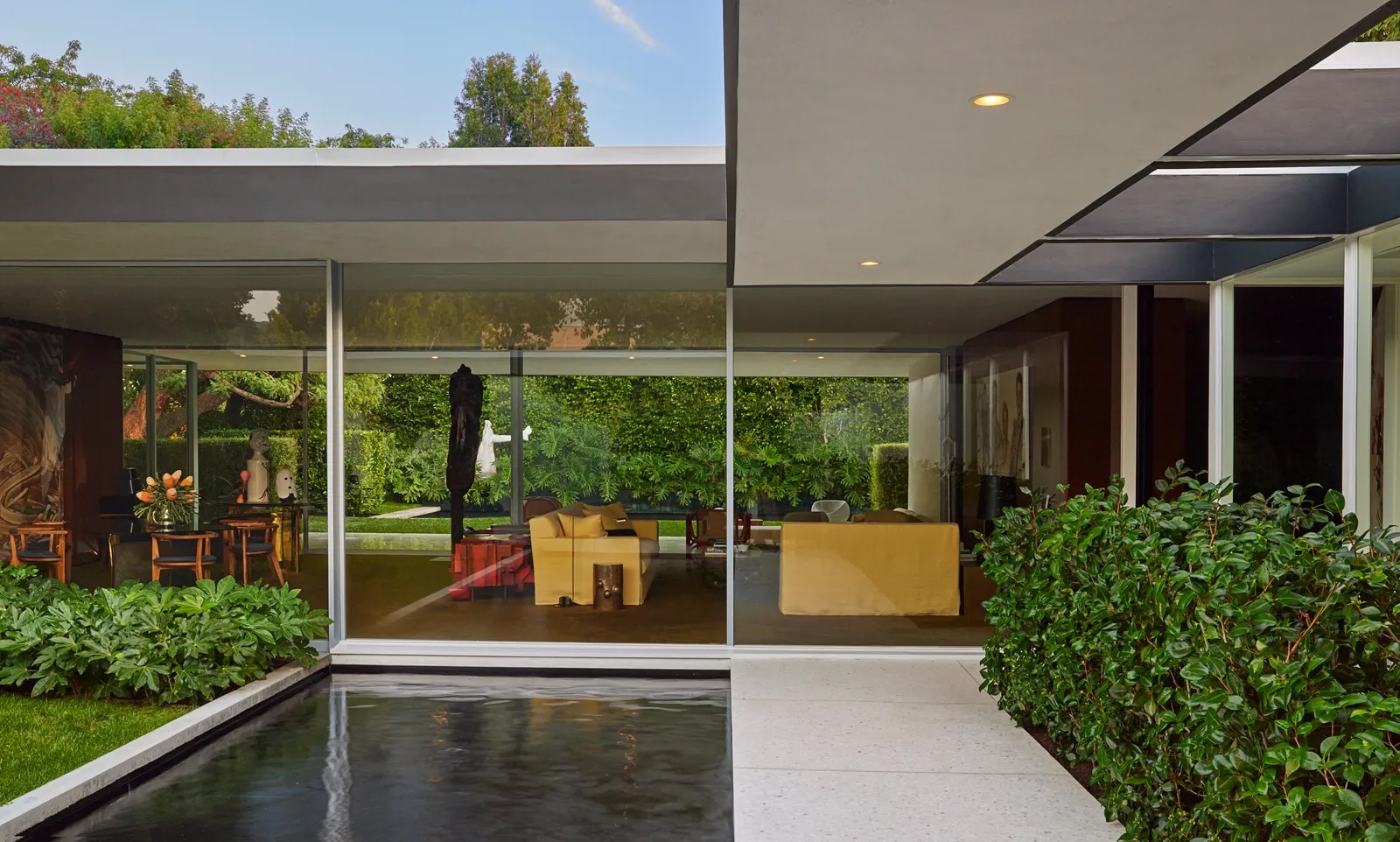In many ways, I’m definitely my father’s daughter, except when it comes to gardens. He collected roses and loved to spend most of the day tending to them. He was not very concerned with how the garden looked. I am the opposite. I did not inherit his “green thumb,” however, a beautifully presented garden knocks me out. The result, every spring I devour stories about garden design, but my execution falls short. Hope springs eternal and this piece for AD Pro is inspiring. I hope you enjoy it too.
Pros weigh in on making green spaces of all varieties both beautiful and flexible
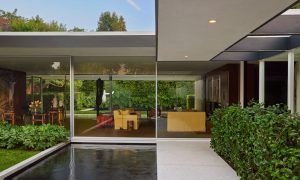
Restored by designer Brad Dunning, this 1960 Donald Polsky home in Los Angeles has views to both its landscaped entry courtyard as well as its garden by Madison Cox. Photo: Yoshihiro Makino / Styling: Anita Sarsidi
No matter the size of a client’s garden, making use of every inch feels more important than ever, supported by the proven wellness benefits of spending time outside. Following prevailing interior trends, flexibility is key in outdoor spaces, which are often called upon to do double or triple duty to support relaxation, gathering, dining, and more. Whether a home has the square footage to host a compact urban backyard or a sprawling landscape, there are ways to artfully and organically integrate a client’s outdoor needs. Here, design and construction experts explain how.
City gardens
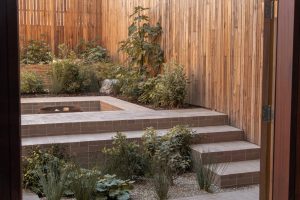
To maximize this 570-square-foot backyard at a home in San Francisco, landscape studio ORCA sunk a fire pit into an elevated brick patio and planted native flora to define different sitting areas. Photo: Cass Cleave
Instead of trying to impose a long list of functions onto small green spaces, “prioritize what is most important,” says Molly Sedlacek, founder of Los Angeles–based landscape studio and AD PRO Directory member ORCA. She recommends cataloguing your client’s wants and then mapping out the square footage needed to help decide what should take precedence.
When you are working with limited space, introducing a change in elevation can make petite gardens feel larger, says Sedlacek. For a 570-square-foot backyard in San Francisco, ORCA sunk a fire pit into a raised area where steps double as seating. Plantings can also help organize different zones. Creating “garden rooms” gives the desirable experience of being enveloped by nature, she adds.
It’s a sentiment shared by Michal Kapitulnik, principal at San Francisco–based landscape architecture firm and AD PRO Directory member Surfacedesign. Layering plants with dramatic structural form creates “a sense of enclosure” for smaller program areas, she says. Playing with materials and textures, too, can create the illusion of depth in a compact space.
Terraces and rooftops
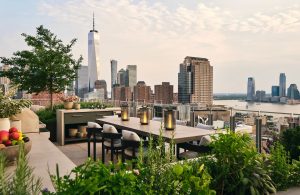
Lush planters help define different areas of this Manhattan rooftop garden designed by RKLA Studio Landscape Architecture, including its outdoor kitchen. Photo: Ty Cole
If much of an outdoor space is exposed to the elements, integrating shading and heaters increases the flexibility for when it can be used, explains Gareth Mahon, partner at New York–based RKLA Studio Landscape Architecture. On terraces and rooftops, Mahon has also seen an increased demand for wellness amenities, including hot tubs, saunas, and cold plunges, which can help conjure the feeling of an oasis within a small footprint.
Strategic planting and furniture selection are vital for optimizing such spaces. “Know what plants will grow large and do the most work in terms of screening, providing shade, and adding beauty—all while limiting the size of the planters that they live in,” says Mahon. Scale is an important consideration for furnishings too. Oversized pieces, or too many of them, can negatively “affect the feel and flow” of a small space, he adds.
Estates
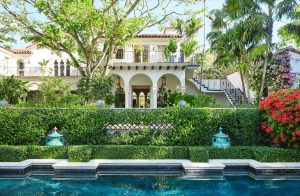
Redesigned by AD100 legend Jacques Grange, this 1930 Palm Beach, Florida, estate features a lush walled garden by Nievera Williams whose subtropical design centers around a banyan tree. Photo: Ngoc Minh Ngo / Styling: Mieke ten Have
When acreage is not an issue, careful design is still paramount. Larger projects require the creative delineation of different outdoor areas, says Kapitulnik, whether through soft planted thresholds or architectural devices. This method helps define a sequence of varied spaces—forming a journey through the garden and creating moments of discovery, privacy, and sociability.
For a more than five-acre project in Sonoma, California, Surfacedesign integrated a feeling of “cinematic procession” through the garden, describes Kapitulnik. “That sense of variation and adventure as you’re moving through the garden keeps it exciting, but also gives you the opportunity to have the garden flex to accommodate different numbers of people—so it never feels empty.”
Poolside
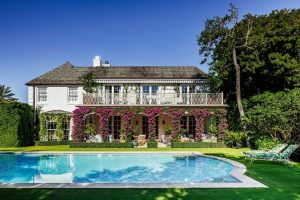
Thanks to landscape studio SMI Landscape Architecture, a lush carpet of lawn surrounds the swimming pool at a historic Palm Beach, Florida, house, decorated by AD100 talent Frank de Biasi. Photo: Kris Tamburello / Styling: Lazaro Arias
A swimming pool presents both opportunities and challenges for its surrounding space, where safety and aesthetics must be considered. To maximize its use, design firms are increasingly folding a variety of functions into the poolside area, from outdoor kitchens to fire pits.
In Arizona, “pools are an absolute must because of the hot summers,” says Brad Leavitt, president of Scottsdale-based company A Finer Touch Construction. For a recent home project in the state in collaboration with CW Architecture, TheLifestyledCo, and CF Design, the builder constructed a sleek infinity pool surrounded by plantings, seating, a fire pit, outdoor kitchen, and a sheltered outdoor entertainment area. The latter connects seamlessly to an indoor lounge through large, glazed retractable doors, blurring the inside-outside boundary. Similarly designed windows allow the indoor bar to open to the poolside area, functioning for both spaces. “Large corner multisliders and pass-through windows are a must on almost every project,” says Leavitt.
In smaller gardens, the pool itself can be a space-saving trick. “If you need entertaining space but don’t have tons of room, you can raise the pool up 14 inches and widen the edge,” says AD100 architect Barbara Bestor. “Then you have a great seating area for 50 people or so.” A well-designed outdoor space can even extend the party. —Francesca Perry

 Facebook
Facebook
 X
X
 Pinterest
Pinterest
 Copy Link
Copy Link
